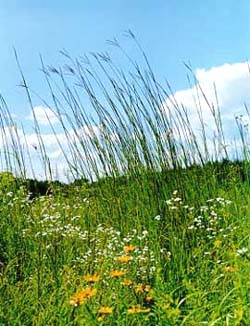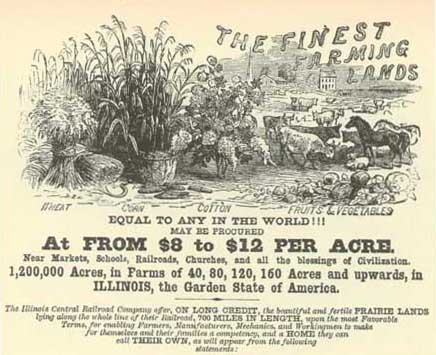
Early Settlement
Illinois and its prairie attracted many immigrants from its opening in the early 1800s to the mid- and late-nineteenth century. The immigrants came from other parts of the United States and from several countries in Europe. The English and the Germans were the two largest ethnic groups to arrive for settlement. They came for many different economic and personal reasons.
The Germans
German immigrants arrived in Illinois in the latter half of the nineteenth century for a combination of other reasons. The inheritance laws in Alsace and East Friesland caused once larger farms to be divided until many were too small in acreage to survive economically. On the other hand in Westphalia, impartible inheritance laws caused non-heirs to be prevented from owning farms. There was overpopulation, bad weather, and the draw of industrial jobs in cities in various areas of Germany that made conditions ripe for emigration. The German farmers who settled in Illinois were not entrepeneurial and commercial as the English were, but had an agrarian tradition of family farms worked intensively at a subsistence level. They followed that tradition when they settled in Illinois.
The English
There were plenty of reasons, public and personal, that caused people to immigrate to Illinois from the east, the south, and from Europe. In England in the eighteenth century, for example, farms were consolidating to grow in size and become more commercially viable. This left small farms with tenant farmers at an economic disadvantage. It also created a large sector of landless hired workers who had no future as landowners. In addition, the inheritance laws of England, which left property only to eldest sons, left many younger siblings without hope of land ownership.
The open lands available for settlement in the United States, particulalry areas such as the newly opended Illinois prairie, appeared as a great opportunity for these small farmers and laborers. They would be able to become entrepeneurs and create their own farms in a short time. This entrepeneurial spirit was very evident in the cases of Morris Birkbeck, George Flower and John Woods, who settled near the Wabash River in 1818.
Some farmers of English origin came to Illinois from the American northeast or Mid-Atlantic states, and some from the upper south including Kentucky and Tennessee. They already followed the commercial farming model, rather than an earlier agrarian model.
Below are some excerpts of testimonies by correspondents, farmers, and others about the reasons they thought they needed to move on to new land. (From Larding the Lean Earth by Steven Stoll (2002) Hill and Wang, New York)
Correspondent of the Cultivator, a Virginia magazine, in a satirical article written in the 1830s. It is based on the practice of farming in which, when acreage becomes exhausted from constant planting and non-fertilization, the farmer cuts more timber and clears new acreage to plow, leaving the exhausted fields to become overgrown with brush for years. When all of his land has been used this way, what is the farmer to do?
"We Virginia farmers, (I mean such as I am, who are at least four-fifths of the whole,) require to have some plan devised, by which, without much labor and with no expense, we may improve our lands, and that speedily, or we will remove to the western forests, and encounter all the labor and privations attending a new settlement. We have no notion of submitting to the tardy and laborious system of your real farmer. We go for a kind of sleight of hand or no work plan - or we are off."
The Governor of South Carolina, 1842-44, James Henry Hammond, talking about the state of his own land:
"If I can get 800 or 1000 marled [with calcium carbonate to lower the acidity of the soil]…I shall be contented here. Two years will fully test this experiment, and if it fails I have no hope left but emigration."
Report from Charleston, Virginia:
"The tide of emigration through this place is rapid, and we believe, unprecedented. It is believed that not less than 8,000 individuals, since the 1st of September last, have passed on this route. They are principally from the lower part of this state and South Carolina, bound for Indiana, Illinois, and Michigan - They jog on, careless of the varying climate, and apparently without regret for the friends and the country they leave behind, seeking forests to fell, and a new country to settle."
The farmers mentioned in the above report preferred to strike out for the West to start another farm rahter than work to restore the soil of their current farm. This situation was replicated from Vermont to South Carolina in the 1820s.
Irish Potato Famine
The Irish potato famine was another reason that many people immigrated to Illinois and the new West in the mid-nineteenth century. New immigrants could work as much-in-demand laborers in Illinois and elsewhere for a few years, then purchase their own land to farm.
Here are some links to narrative and news reports of the time:
Article from University of Virginia Web site on the
Irish Potato Famine 1846-1850.
Newspaper articles and print images of the time from Great Britain on the
Vassar Web site.
Illinois Central Railroad Land Sales

The Federal Land Grant Law of 1851 granted 2.5 million acres of Illinois public land to the new Illinois Central Railroad. The land ran along the planned route of the I.C. Railroad from Chicago to Cairo, a distance of 700 miles. The railroad could sell acreage after the other federal land in an area had been sold. From the sales of these lands, the railroad finianced its lines. In turn, the farmers hired the railroad to ship its commodities to market. Land where it is known a railroad will locate was a strong attraction to prospective buyers.







